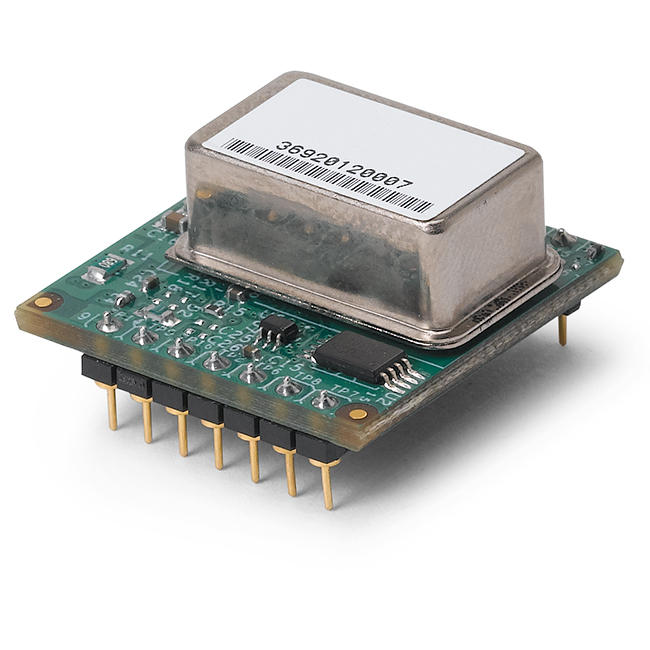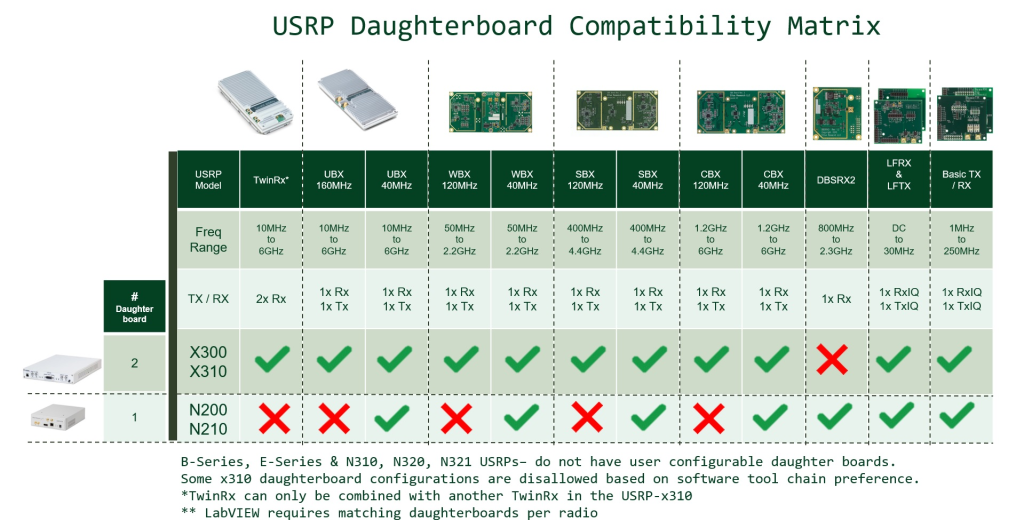您的购物车目前是空的!
标签: USRP X300
-
Board Mounted GPSDO (OCXO) Recommended for USRP X300/X310
783173-01 | GPSDO for USRP X Series (PCB-Mounted GPS-Disciplined OCXO) $ 2,130.00 USD
This is a GPS-disciplined, oven-controlled crystal oscillator (GPSDO), which is compatible with a USRP X300 or X310. The GPSDO provides a high-accuracy 10 MHz reference and 1 PPS signal. This allows developers to build system that serve applications with tight synchronization requirements, or global timing alignment within 50 ns.

Overview
This is a GPS-disciplined, oven-controlled crystal oscillator (GPSDO), which is compatible with a USRP X300 or X310. It can also be used with the USRP B200/B210, but the system will require external power. The GPSDO provides a high-accuracy 10 MHz reference and 1 PPS signal, which allow developers to build systems that serve applications with improved frequency accuracy and global timing alignment.
We recommend reading the GPSDO Selection Guide to ensure this is the right device for your application.
Module Specifications 1 PPS Accuracy ±50ns to UTC RMS (1-Sigma) GPS Locked Holdover Stability <±20µs over 3 hour period at +25C 1 PPS Output (OCXO Flywheel Generated) 3.3VDC CMOS RS-232 Control NMEA & SCPI-99 Control Commands, Integrated into UHD GPS Frequency L1, C/A 1574MHz GPS Antenna Active (5V compatible) or Passive GPS Receiver 50 Channels, Mobile, WAAS, EGNOS, MSAS capable Sensitivity Acquisition -142dBm, Tracking -168dBm TTFF Cold Start: <45 sec, Warm Start: 1 sec, Hot Start: 1 sec ADEV 1E-11 at 1s Warm Up Time / Stabilization Time <5 min at +25C to 1E-08 Accuracy Supply Voltage (Vdd) 3.3/5VDC Power Consumption 0.7W Max Operating Temperature 0C to +60C Storage Temperature -45C to 85C Oscillator Specifications Frequency Output 10MHz 10MHz Retrace ±2E-08 after 1 hour at 25C Frequency Stability Over Temperature (Unlock Condition) ±2.5E-08 Warm Up Time < 1 min at +25C Phase Noise at 10MHz 1Hz -75dBc/Hz 10Hz -110dBc/Hz 100Hz -132dBc/Hz 1kHz -142dBc/Hz 10kHz <-145dBc/Hz Additional Resources
Kit Contents:
- Board-Mounted GPSDO (OCXO)
- Documentation for Installation and Configuration/Setup
Recommended for Use With:
- A USRP X300 and USRP X310 for a high-accuracy clock reference.
- Add a GPSDO Mini GPS Antenna to synchronized the GPSDO to the GPS constellation for 25 ppb frequency accuracy and 50 ns alignment across the globe.
-
USRP X300
783144-01 | USRP X300 (KINTEX7-325T FPGA, 2 CHANNELS, 10GIGE AND PCIE BUS) $ 8,544.00 USD
The Ettus Research USRP X300 is a high-performance, scalable software-defined radio (SDR) platform for designing and deploying next-generation wireless communications systems.

Overview
The Ettus Research USRP X300 is a high-performance, scalable software-defined radio (SDR) platform for designing and deploying next-generation wireless communications systems. The hardware architecture combines two extended-bandwidth daughterboard slots covering DC – 6 GHz with up to 160 MHz of baseband bandwidth, multiple high-speed interface options (PCIe, dual 10 GigE, dual 1 GigE), and a large user-programmable Kintex-7 FPGA in a convenient desktop or rack-mountable half-wide 1U form factor. In addition to providing best-in-class hardware performance, the open source software architecture of X300 provides cross-platform UHD driver support making it compatible with a large number of supported development frameworks, reference architectures, and open source projects.
Operating Systems LinuxWindows Development Frameworks GNU Radio
Xilinx Vivado 2015.2 Design SuiteTable 1: Operating systems, development frameworks, and reference applications
High-Performance User-Programmable FPGA
At the heart of the USRP X300, the XC7K325T FPGA provides high-speed connectivity between all major components within the device including radio frontends, host interfaces, and DDR3 memory. The default FPGA core provided with UHD provides all of the functional blocks for digital down-conversion and up-conversion, fine-frequency tuning, and other DSP functions allowing it to be interchangeable with other USRP devices using the UHD architecture. The large Kintex-7 FPGA provides additional space for developers to incorporate custom DSP blocks and is compatible with a large number of USRP-supported development frameworks, reference architectures, and open source projects.
USRP N210 USRP X300 USRP X310 FPGA Spartan3 XC3SD3400A Kintex 7-325T Kintex 7-410T Logic Cells 53k 321k 406k Memory 2,268 Kb 16,020 Kb 28,620 Kb Multipliers 126 840 1540 Clock Rate 100 MHz 200 MHz 200 MHz Streaming Bandwidth per Channel (16-bit) 25 MS/s 200 MS/s 200 MS/s Table 2: FPGA resource comparison
Multiple High-Speed Interface Options
The USRP X300 provides multiple interface options. Out of the box, 1 GigE provides a convenient way to get started. For extended bandwidth and lower latency applications such as PHY/MAC research, PCIe x4 provides an efficient bus for deterministic operation. Applications using network recorders or multiple processing nodes can be best served by the 10 GigE interface option.
Additional Features- GPSDO, GPIO, 1 GB DDR3, Synchronization
The X300 includes many additional features that facilitate wireless system development. On-board 1GB DDR3 with flexible access through the FPGA reference design supplements the FPGA resources with buffering and data storage memory. An optional internal GPSDO provides a high-accuracy frequency reference, and global timing alignment to within 50 ns when synchronized to the GPS system. The external GPIO connector allows users to control external components such as amplifiers and switches, accept inputs like event triggers, and observe debug signals. The USRP X300 also includes an internal JTAG adapter that allows FPGA developers to easily load and debug new FPGA images.
Compatible RF Daughterboards: UBX, CBX, WBX, SBX, LFRX, LFTX, Basic TX/RX)

Features
- Two wide-bandwidth RF daughterboard slots
- Large customizable Xilinx Kintex-7 FPGA for high-performance DSP (XC7K325T)
- Multiple high-speed interfaces
- Dual 10 Gigabit Ethernet – 2x RX at 200 MSPs per channel
- Dual 10 Gigabit Ethernet – 4x RX at 80 MSPs per channel
- PCIe Express (Desktop) – 200 MS/s Full Duplex
- ExpressCard (Laptop) – 50 MS/s Full Duplex
- Dual 1 Gigabit Ethernet – 25 MS/s Full Duplex
- UHD architecture provides compatibility with
- GNU Radio
- C++/Python API
- Amarisoft LTE 100
- OpenBTS
- Other third-party software and frameworks
- Flexible clocking architecture
- Configurable sample clock
- Optional GPS-disciplined OCXO
- Coherent operation with OctoClock and OctoClock-G
- Compact and rugged half-wide 1U form factor for convenient desktop or rack mount usage
- Digital I/O accessible on the front panel for custom control and interfacing from the FPGA
Additional Resources
Included in This Kit:
- USRP X300
- 1 Gigabit Ethernet Cable
- SFP Adapter for 1 GigE
- Power Supply
- USB 2.0 Cable for Internal JTAG Adapter
- Four SMA-Bulkhead Cables
- Getting Started Guide
Quotes and Sales
Email:sales@tekdf.com
Wechat:dftech_info